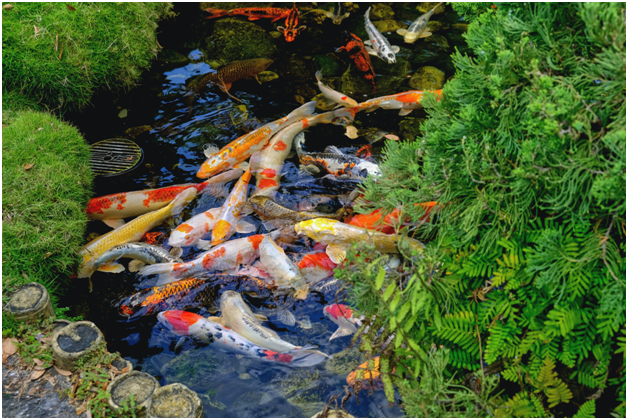Raising koi fish can be an exciting and rewarding experience, but buying koi fish requires the right knowledge and preparation. Whether you’re building your first pond or adding koi to an existing one, understanding how to care for these beautiful fish is essential. At Laguna Koi Ponds, we have over 30 years of experience importing and raising koi fish from Japan, and we’ve created this beginner’s guide to help you get started.
What Are Koi Fish?
Koi fish are a domesticated variety of carp that have been selectively bred for their vibrant colors and patterns for over 200 years. Originating from Japan, they hold deep cultural significance in Asia and beyond. In Japan, koi symbolize strength, love, prosperity, and good fortune. In China, they represent fame, wealth, and perseverance. Because of their stunning appearance and peaceful nature, koi fish are a favorite among pond enthusiasts worldwide.
Popular Types of Koi Fish
Koi fish come in many different colors and patterns. While there are many varieties, here are some of the most popular ones you may encounter:
- Kohaku – These koi have a white body with red markings and are one of the most well-known varieties.
- Taisho Sanke – Similar to Kohaku, but with additional black markings that make them stand out.
- Showa Sanshoku – These koi have a black body with red and white patterns, giving them a bold look.
- Butterfly Koi – Known for their long, flowing fins, these koi can have a variety of colors and patterns.
- Ogon – Solid-colored koi, usually gold or platinum, that shine beautifully in the water.
Each variety has unique traits, but all koi fish can coexist in the same pond, creating a stunning and colorful display.
How Big Do Koi Fish Get?
Many beginners are surprised to learn that koi fish can grow quite large. While the average koi reaches 12 to 15 inches in length, some can grow up to 36 inches (3 feet) or more under the right conditions.
Important factors that affect koi growth:
- Pond size – A spacious pond allows koi to grow to their full potential.
- Water quality – Clean, well-filtered water promotes healthy growth.
- Nutrition – A balanced diet helps koi reach their full size and stay healthy.
If you’re starting out, ensure your pond is at least 1,000 gallons in size and 3-4 feet deep to give your koi enough room to swim and grow.
What Do Koi Fish Eat?
Koi fish are omnivores, meaning they eat both plant and animal matter. In nature, they feed on algae, insects, and larvae, but in a pond, they require a balanced diet to stay healthy.
Best Foods for Koi:
- High-quality koi pellets – Provide essential nutrients for growth and immune support.
- Fruits and vegetables – Lettuce, watermelon, and peas make great occasional treats.
- Protein sources – Shrimp and earthworms can be added for variety, especially for young koi.
Be sure not to overfeed your koi, as uneaten food can dirty the water. A good rule of thumb is to feed only what they can eat in 5-10 minutes and remove any leftovers.
How to Set Up a Koi Pond
Creating a proper environment is essential for your koi’s health and well-being. Here’s what you need to consider:
1. Pond Size and Depth
- A minimum of 1,000 gallons is recommended.
- Depth should be at least 3-4 feet to protect koi from temperature changes.
2. Filtration and Water Quality
- Use a high-quality filter to remove waste and keep the water clean.
- Test your pond’s water regularly to ensure healthy conditions:
- Ammonia & Nitrites: 0 ppm
- Nitrates: Below 40 ppm
- pH: Between 6.8 and 8.4
- Temperature: Ideally between 60-75°F
3. Oxygenation
- Install an aeration system, such as an air pump or waterfall, to keep oxygen levels high.
Seasonal Koi Care
Koi fish need different care depending on the season, as their metabolism changes with the temperature.
- Summer: Feed koi more frequently as their metabolism is high. Monitor oxygen levels.
- Fall: Reduce feeding and switch to wheat germ-based food, which is easier to digest.
- Winter: When water drops below 50°F, stop feeding. Koi go into a dormant state.
- Spring: Gradually resume feeding and watch for signs of illness as koi become more active.
Choosing Healthy Koi Fish
When buying koi, choose fish that look healthy and are active. Here’s what to look for:
- Bright, vibrant colors and even patterns
- Clear eyes with no cloudiness
- Smooth, clean scales without sores or lesions
- Active swimming behavior
At Laguna Koi Ponds, we carefully select our koi to ensure they are healthy and high-quality. With decades of experience, we are dedicated to helping you create a thriving koi pond.
Final Thoughts
Raising koi fish can be a fulfilling hobby, but it requires the right care and environment. By setting up a proper pond, providing a nutritious diet, and maintaining good water quality, you can enjoy these beautiful fish for many years. If you have any questions or need help getting started, feel free to contact us at Laguna Koi Ponds—we are happy to assist you!



